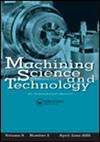Thermomechanical modeling of crystallographic anisotropy effect on machining forces based on crystal plasticity framework
IF 2.6
4区 工程技术
Q2 ENGINEERING, MANUFACTURING
引用次数: 1
Abstract
Abstract In this work, the effect of the crystallographic anisotropy on machining forces is studied through a thermomechanical approach based on rate sensitive plasticity based model. A crystal plasticity framework is adopted to formulate the required constitutive equations. The present approach takes into account the material thermoviscoplastic response, the shear strain rate distribution in the primary shear zone and their effects on the lattice rotation. The machining forces as well as the corresponding specific energies are calculated using two methods: (a) the total power minimization procedure and (b) the Merchant shear angle procedure. The proposed model is validated using cutting force data available in the literature. Then, it is used to gain insight into the effect of the crystallographic anisotropy on machining forces. According to the results, a strong dependence of the machining forces to the crystallographic orientations is obtained. The model is also used to analyze the of the cutting velocity on the shearing along crystallographic slip systems through the material thermomechanical response. In addition, it is observed that, compared to the total power minimization procedure, the Merchant shear angle procedure allows capturing the specific cutting energy trends due to the crystallographic anisotropy, in terms of peaks and valleys.基于晶体塑性框架的晶体各向异性对加工力影响的热力学建模
摘要本文采用基于速率敏感塑性模型的热力学方法,研究了晶体各向异性对加工力的影响。采用晶体塑性框架建立了所需的本构方程。该方法考虑了材料的热粘塑性响应、主剪切区剪切应变率分布及其对晶格旋转的影响。加工力以及相应的比能使用两种方法计算:(a)总功率最小化程序和(b) Merchant剪切角程序。利用文献中提供的切削力数据验证了所提出的模型。然后,利用它来深入了解晶体各向异性对加工力的影响。结果表明,加工力对晶体取向有很强的依赖性。该模型还通过材料的热力学响应分析了切削速度对沿晶滑系统剪切的影响。此外,可以观察到,与总功率最小化程序相比,Merchant剪切角程序可以捕获由于晶体各向异性(峰谷)而产生的特定切割能量趋势。
本文章由计算机程序翻译,如有差异,请以英文原文为准。
求助全文
约1分钟内获得全文
求助全文
来源期刊

Machining Science and Technology
工程技术-材料科学:综合
CiteScore
5.70
自引率
3.70%
发文量
18
审稿时长
6 months
期刊介绍:
Machining Science and Technology publishes original scientific and technical papers and review articles on topics related to traditional and nontraditional machining processes performed on all materials—metals and advanced alloys, polymers, ceramics, composites, and biomaterials.
Topics covered include:
-machining performance of all materials, including lightweight materials-
coated and special cutting tools: design and machining performance evaluation-
predictive models for machining performance and optimization, including machining dynamics-
measurement and analysis of machined surfaces-
sustainable machining: dry, near-dry, or Minimum Quantity Lubrication (MQL) and cryogenic machining processes
precision and micro/nano machining-
design and implementation of in-process sensors for monitoring and control of machining performance-
surface integrity in machining processes, including detection and characterization of machining damage-
new and advanced abrasive machining processes: design and performance analysis-
cutting fluids and special coolants/lubricants-
nontraditional and hybrid machining processes, including EDM, ECM, laser and plasma-assisted machining, waterjet and abrasive waterjet machining
 求助内容:
求助内容: 应助结果提醒方式:
应助结果提醒方式:


